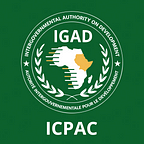The Horn of Africa’s Blue Carbon Heroes: Seaweeds and Mangroves in the Fight Against Climate Change
By Jebet Vicky With contributions from the IGAD Climate Change Technical Working Group
The Horn of Africa faces many climate challenges, but amidst these threats, there are two unique ecosystems that offer a glimmer of hope: seaweed and mangroves. Often overlooked, these vibrant underwater forests and towering coastal sentinels act as nature’s carbon capture machines and guardians against rising sea levels.
Seaweed, with its various forms, serves as nature’s efficient carbon capture agents. Through photosynthesis, they absorb dissolved carbon dioxide from the water and store it within their tissues. When they decompose, this captured carbon is securely stored in the seabed, preventing its release back into the atmosphere and curbing global warming. This advantage of “blue carbon” highlights the invaluable role seaweed plays in combating climate change. Their natural and sustainable solution offers significant carbon sequestration potential, far exceeding that of terrestrial forests.
On the other hand, mangrove forests protect coastal communities from storms and floods and serve as natural barriers against rising sea levels. Their intricate root systems trap sediments, preventing coastal erosion and maintaining healthy beaches. But their contributions extend far beyond physical protection. Mangroves, too, are carbon-sequestration powerhouses, storing five times more carbon per unit area than tropical rainforests, making them crucial players in mitigating climate change.
They also act as nurseries for fish, bolstering food security and promoting vibrant fisheries. According to the World Bank, an estimated 4.1 million small-scale fishers rely on mangroves for their livelihoods. Additionally, they generate employment opportunities, filter water for a healthy ocean, shield coastal communities from climate disasters, and provide vital habitats for diverse wildlife, significantly contributing to several Sustainable Development Goals (SDGs).
These vital ecosystems face a grave threat: plastic pollution. The Indian Ocean for example, bears the brunt of this issue, receiving a staggering 37,000 metric tons of plastic waste annually. This endangers seaweed and mangroves. They entangle and suffocate seaweed, hindering its growth, and disrupting its vital role in carbon capture. Similarly, plastic pollution harms mangroves by blocking their roots and hindering nutrient uptake, weakening their capacity to combat climate change and jeopardizing the coastal communities that rely on their protection.
Despite the challenges, research is uncovering innovative solutions, like utilizing seaweed for bioplastics and developing biodegradable alternatives to plastics. These advancements have the potential to decrease plastic pollution and create new sustainable industries, empower local communities in coastal regions, and protect the environment.
Community-driven initiatives are driving mangrove restoration. By investing in these solutions and empowering local communities, we can preserve these ocean guardians and unlock their full potential in mitigating climate change. One exemplary model showcasing the initiatives’ potential is Mikoko Pamoja, a groundbreaking community development project in Kenya’s coastal region. The name itself, “Mikoko Pamoja,” which means “mangroves together” in Swahili, capturing the importance of working together.
At the heart of Mikoko Pamoja’s success story lies an innovative approach to carbon credits. The project conserves and protects mangrove ecosystems, representing a substantial portion of Gazi Bay’s ecosystem. Between 2013 to 2033, Mikoko Pamoja aims to safeguard large areas of natural mangrove forests and maintain newly planted areas that were once bare.
Seaweed aquaculture, involving the cultivation of seaweed in controlled environments, is a valuable method for carbon capture and sustainable livelihoods. By replicating the natural carbon sequestration, seaweed farms can capture and store carbon, potentially paving the way for blue carbon projects that benefit the environment and provide sustainable livelihoods for coastal communities.
Restoring blue carbon ecosystems not only increases their carbon storage capacity, but also creates sustainable livelihoods for local communities through eco-tourism and fishing practices (SDG 8). This aligns perfectly with the blue economy’s principles of sustainable ocean resource use for economic growth and job creation (SDG 14). Healthy restored ecosystems further contribute to healthy marine life (SDG 14) by providing critical habitat, filtering pollutants from water (SDG 6), and protecting shorelines from erosion (SDG 15).
By tackling plastic pollution and investing in community-driven innovation, we can unlock the full potential of these ocean guardians. Mitigating climate change, fostering thriving coastal communities, and achieving the SDGs hinges on a united effort. Individuals, communities, governments, and organizations must join forces. Let’s support these initiatives, embrace sustainable practices, and champion the protection of blue carbon ecosystems. By harnessing the power of the blue economy and investing in mangrove restoration, we can secure a healthier planet and a resilient future for all.
